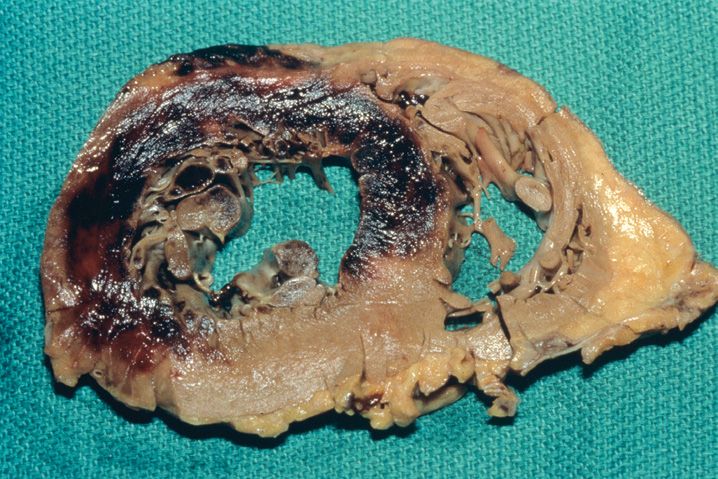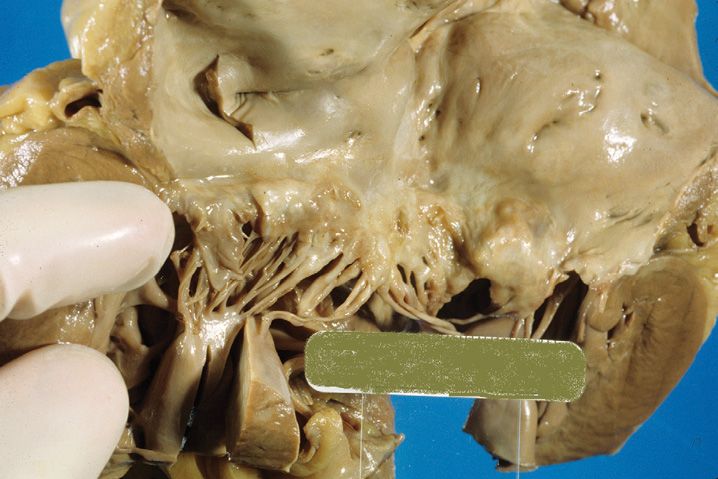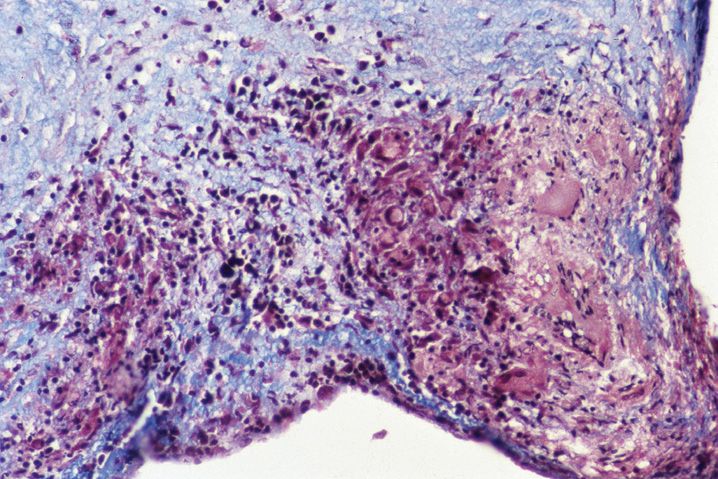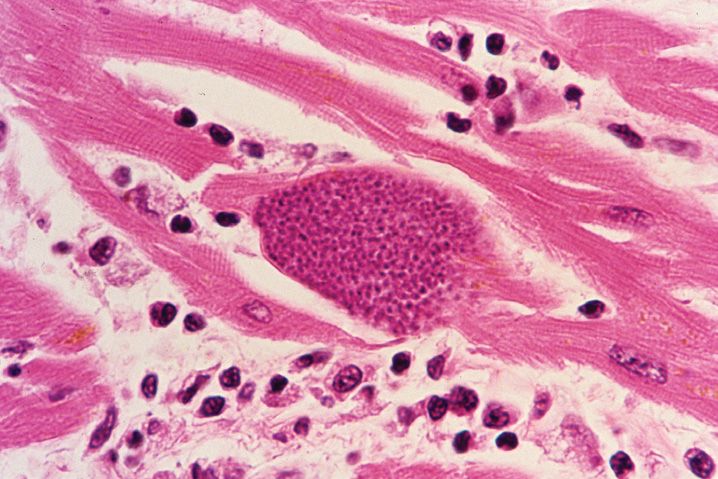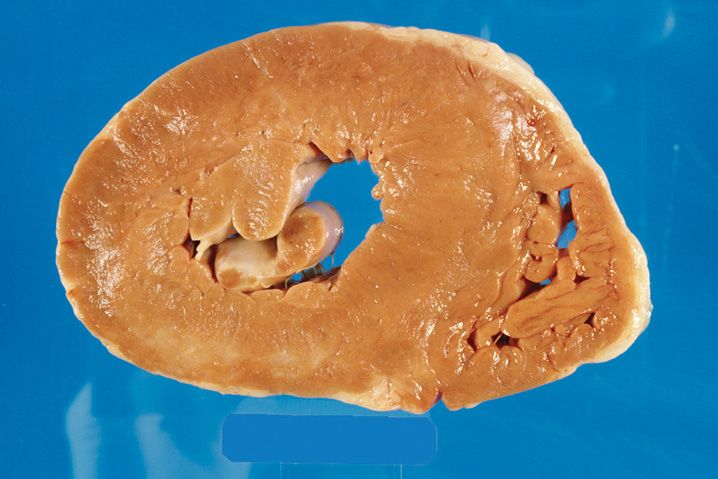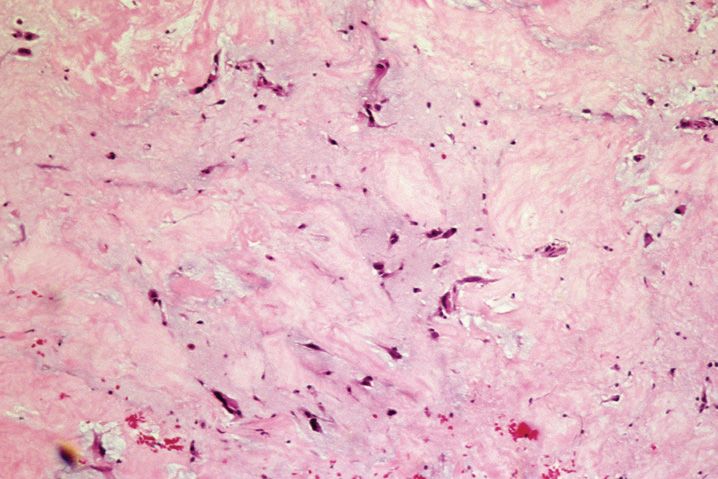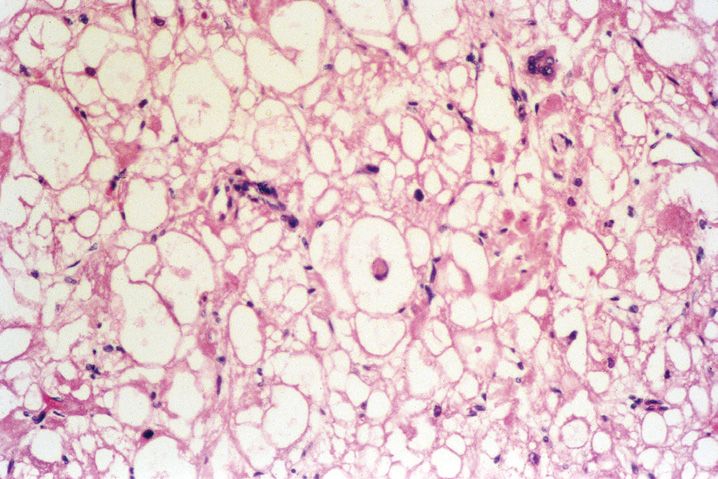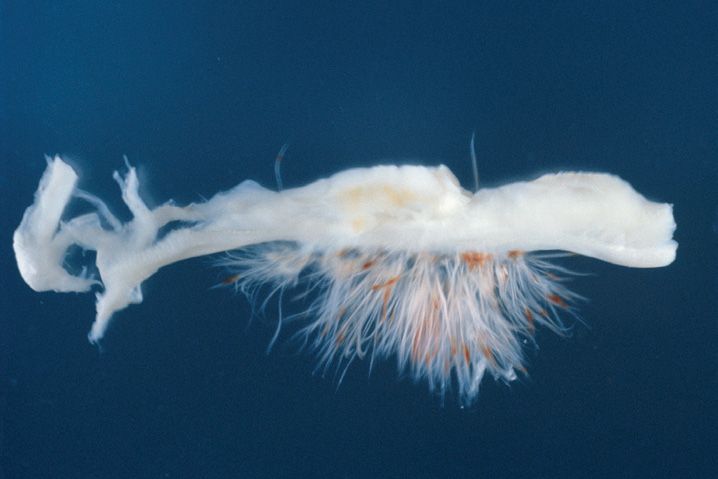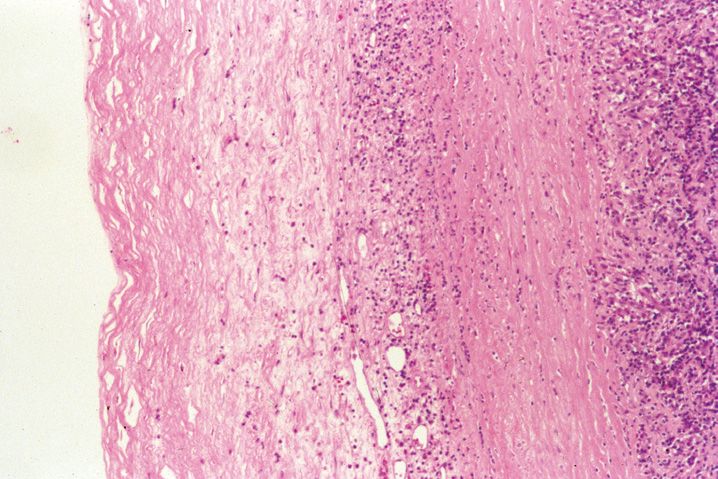FIGURE 7-1
(A) Cardiac amyloidosis
(B) Diabetes
(C) Primary pulmonary hypertension
(D) Renal artery stenosis
(E) Systemic hypertension
11. The most commonly encountered congenital heart defect is which of the following?
(A) Atrial septal defect
(B) Patent ductus arteriosus
(C) Pulmonary stenosis
(D) Tetralogy of Fallot
(E) Ventricular septal defect
12. Which of the following cardiac defects is associated with fibrillin mutations (Marfan syndrome)?
(A) Atrial septal defect
(B) Pulmonary stenosis
(C) Tetralogy of Fallot
(D) Truncus arteriosus
(E) Valvular abnormalities
13. The most common genetic cause of congenital heart disease is which of the following?
(A) Klinefelter syndrome
(B) Trisomy 13
(C) Trisomy 18
(D) Trisomy 21
(E) Turner syndrome
14. Evidence of paradoxical embolism is most likely to be encountered with which of the following?
(A) Atrial septal defect
(B) Atrioventricular septal defect
(C) Patent ductus arteriosus
(D) Tetralogy of Fallot
(E) Ventricular septal defect
15. In the fetal circulation, the ductus arteriosus shunts blood from the
(A) Aorta to the pulmonary artery
(B) Aorta to the pulmonary vein
(C) Pulmonary artery to the aorta
(D) Pulmonary artery to the pulmonary vein
(E) Pulmonary vein to the aorta
16. A 2-day-old newborn is autopsied and a complex cardiac malformation is discovered at autopsy. You suspect a tetralogy of Fallot. All of the following are features you expect to find except
(A) Overriding aorta
(B) Right ventricular hypertrophy
(C) Subpulmonary stenosis
(D) Tricuspid atresia
(E) Ventricular septal defect
17. Which of the following cardiac malformations is likely to present with cyanosis early in life?
(A) Atrial septal defect
(B) Patent ductus arteriosus
(C) Patent foramen ovale
(D) Tetralogy of Fallot
(E) Ventricular septal defect
18. Which of the following is not a usual feature of a total anomalous pulmonary venous connection?
(A) Hypertrophic left ventricle
(B) Hypoplastic left atrium
(C) Pulmonary trunk dilation
(D) Right ventricular dilation
(E) Right ventricular hypertrophy
19. A 42-year-old woman has a history of hypertension in the upper extremities and hypotension in the lower extremities. She has radiographic evidence of erosions of the undersurfaces of the ribs. A holosystolic murmur was noted on physical exam. Which of the following autopsy findings would best explain her presentation?
(A) Coarctation of the aorta
(B) Patent ductus arteriosus
(C) Persistent truncus arteriosus
(D) Pulmonary stenosis
(E) Transportation of the great arteries
20. A 12-year-old suspected of having Williams–Beuren syndrome is being autopsied. She has an “elfin” facial appearance with hypercalcemia, cognitive impairment, widely spaced teeth, and colic and nocturnal enuresis. Which of the following findings would most likely be encountered in the heart?
(A) Myxoid mitral valve
(B) Patent ductus arteriosus
(C) Pulmonary atresia
(D) Supraclavicular aortic stenosis
(E) Tricuspid stenosis
21. In examining coronary arteries, a fixed lesion obstructing what percent of the vessel lumen is generally required to cause ischemia precipitated by exercise?
(A) 25%
(B) 40%
(C) 50%
(D) 60%
(E) 75%
22. Which of the following represents episodic myocar-dial ischemia caused by coronary artery spasm?
(A) Crescendo angina
(B) Prinzmetal angina
(C) Stable angina
(D) Typical angina
(E) Unstable angina
23. In the absence of significant coronary artery disease, all of the following should be looked for at autopsy as potential explanations for an acute transmural myocardial infarct except
(A) Basilar artery aneurysm
(B) Evidence of cocaine use
(C) Infective endocarditis
(D) Vascular dissection
(E) Vasculitis
24. Which of the following best explains the pathologic finding illustrated (Figure 7-2) in a 62-year-old male?
(A) Cardiopulmonary resuscitation
(B) Fat emboli
(C) Multiple myeloma
(D) Renal cell carcinoma
(E) Sickle cell disease
25. Which of the following is least important in determining the location, size, and morphology of a myocardial infarct?
(A) Duration of occlusion
(B) Heart rate
(C) Metabolic needs
(D) Rate of coronary artery thrombus development
(E) Size of the coronary artery
26. This lesion seen (Figure 7-3) in the heart of a 47-year-old male represents which of the following?
(A) Myocardial infarct—2 hours
(B) Myocardial infarct—24 hours
(C) Myocardial infarct—5 days
(D) Myocardial infarct—>1 week
(E) Postmortem artifact
27. A myocardial infarct marked by a prominent neutrophilic component and coagulative necrosis with loss of myocyte nuclei and striation is approximately how old?
(A) 12 hours
(B) 1 day
(C) 2 days
(D) 5 days
(E) 1 week
28. In acute myocardial infarcts (2–3 hours old), immersing tissue sections in which solution can be helpful in identifying the lesion?
(A) Luxol fast blue
(B) Methylene blue
(C) Periodic acid Schiff
(D) Sulfated alcian blue
(E) Triphenyltetrazolium chloride
29. Which of the following findings is most suggestive of reperfusion injury in an ischemic myocardium?
(A) Granulation tissue
(B) Increased eosinophils
(C) Myocardial necrosis with hemorrhage and contraction bands
(D) There are no morphologic correlates
(E) Yellow-white gross appearance
30. Which of the following is the least likely finding in a 72-year-old male who sustained a myocardial infarct with subsequent myocardial rupture?
(A) Acute ventriculoseptal defect
(B) Cardiac tamponade
(C) Fibrinous pericarditis
(D) Hemopericardium
(E) New onset mitral regurgitation
31. Which of the following would be the least likely to be encountered in a 62-year-old male who had a left ventricular aneurysm at autopsy secondary to a myocardial infarct?
(A) History of arrhythmia
(B) History of dyspnea on exertion
(C) Mural thrombus
(D) Pedal edema
(E) Rupture of the aneurysm wall
32. The most common cause of a fatal arrhythmia resulting in sudden cardiac death is which of the following?
(A) Acute myocardial ischemia
(B) Aortic stenosis
(C) Illicit drug use
(D) Mitral valve prolapse
(E) Myocarditis
33. A 42-year-old male, at autopsy, is noted to have a dilated and hypertrophic right ventricle with mild fibrous thickening of the tricuspid valve. All of the following are possible explanations for these findings except
(A) Chronic obstructive pulmonary disease
(B) Diffuse pulmonary interstitial fibrosis
(C) Marked obesity
(D) Massive pulmonary embolus
(E) Primary pulmonary hypertension
34. All of the following are true regarding bicuspid aortic valves except
(A) Increased risk of developing aortic dilation
(B) May cause regurgitation
(C) Mitral valve is usually normal in congenital bicuspid aortic valve cases
(D) Prevalence of approximately 5–10%
(E) Responsible for about half of all aortic stenosis cases in adults
35. The changes shown (Figure 7-4) in this mitral valve of a 50-year-old male are secondary to which of the following?
(A) Congenital abnormality
(B) Infective endocarditis
(C) Marfan syndrome
(D) Myxomatous degeneration
(E) Rheumatic fever
36. Which of the following is not a finding associated with rheumatic heart disease?
(A) Fibrinoid necrosis of heart valves
(B) Foci of lymphocytes, macrophages, and plasma cells
(C) Left atrial thickenings
(D) Pancarditis
(E) The aortic valve is the most frequently involved heart valve.
37. A 60-year-old woman dies of septicemia and multifocal brain infarcts. Needle track marks are found on the legs and forearms. The most likely etiologic agent is which of the following?
(A) Aspergillus fumigatus
(B) Haemophilus species
(C) Kingella species
(D) Staphylococcus aureus
(E) Streptococcus viridans
38. At autopsy, all of the following findings are suggestive of bacterial endocarditis except
(A) Janeway lesions
(B) Osler nodes
(C) Roth spots
(D) Splinter hemorrhages
(E) Trousseau syndrome
39. A 36-year-old woman has multiple small, sterile pink vegetations with a warty appearance on the undersurface of the atrioventricular valves microscopically. The involved heart valves show focal valvulitis with fibrinoid necrosis. The underlying etiology of these vegetations is which of the following?
(A) Ankylosing spondylitis
(B) Rheumatic fever
(C) Sarcoid
(D) Syphilis
(E) Systemic lupus erythematosus
40. A 49-year-old male is diagnosed with a carcinoid tumor of the lung. Which of the following cardiac manifestations is most likely to develop as part of carcinoid heart disease?
(A) Aortic valve insufficiency
(B) Aortic valve stenosis
(C) Mitral valve stenosis
(D) Pulmonary valve insufficiency
(E) Tricuspid valve insufficiency
41. Which of the following complications of a prosthetic mitral valve is best illustrated (Figure 7-5) in this 38-year-old male?
(A) Infective endocarditis
(B) Metastatic carcinoma embolus adherence
(C) Myxoma
(D) Thrombosis
(E) Valve dehiscence
42. A 42-year-old male presents with a dilated cardiomyopathy at autopsy. Which of the following conditions would least likely explain this presentation?
(A) Alcohol use
(B) Doxorubicin use
(C) Glycogen storage disease
(D) Hemochromatosis
(E) Myocarditis
43. A 46-year-old male presents with systolic dysfunction and a dilated cardiomyopathy. A biopsy of the heart is taken, and the pathology is shown in Figure 7-6. The most likely etiology of the cardiomyopathy is which of the following?
(A) Alcohol
(B) Amyloidosis
(C) Fabry disease
(D) Radiation
(E) Sarcoidosis
44. A variety of cytoskeletal protein abnormalities have been described as genetic causes of dilated cardiomyopathy including all of the following proteins except
(A) Desmin
(B) Dystrophin
(C) Myosin-binding protein C
(D) Sarcoglycan
(E) Titin
45. A patient presents with Naxos syndrome, characterized by planter and palmer hyperkeratosis of the skin and a mutation in the plakoglobin gene. Which of the following cardiac abnormalities is likely to be encountered in this patient?
(A) Amyloid accumulation
(B) Hypersensitivity myocarditis
(C) Loeffler endomyocarditis
(D) Mitral valve prolapse
(E) Right ventricular cardiomyopathy
46. A 24-year-old male is diagnosed with a hyper-trophic cardiomyopathy. All of the following are expected pathologic findings in the heart except
(A) Endocardial thickening of the left ventricular outflow tract
(B) Interstitial fibrosis
(C) Myofiber disarray
(D) Thickening of the aortic valve leaflets
(E) Ventricular septal thickening
47. A 46-year-old female presents with a myeloproliferative disorder, a large cardiac mural thrombus, and eosinophilia. This patient is at risk for developing which of the following?
(A) Endocardial fibroelastosis
(B) Hypersensitivity myocarditis
(C) Loeffler endomyocarditis
(D) Parasitic infection
(E) Systemic lupus erythematosus
48. The finding shown in (Figure 7-7) this heart biopsy from a 38-year-old male is most consistent with an infection by which organism?
(A) Borrelia
(B) Candida
(C) Neisseria
(D) Toxoplasma
(E) Trichinella
49. A 72-year-old male with a history of restrictive cardiomyopathy is autopsied. The heart is shown in cross section (Figure 7-8). There is no evidence of significant disease in the other organs examined. The findings are most consistent with which of the following diagnoses?
(A) Chagas disease
(B) Coxsackie virus B myocarditis
(C) Hemochromatosis
(D) Hypothyroidism
(E) Senile cardiac amyloidosis
50. The heart shown here is from a 48-year-old female. Which of the following would least likely explain the finding illustrated in Figure 7-9?
(A) Hyperthyroidism
(B) Postoperative trauma
(C) Rheumatic fever
(D) Systemic lupus erythematosus
(E) Uremia
51. The most common site of origin of the mass seen in a 52-year-old female is (Figure 7-10)
(A) Left atrium
(B) Left ventricle
(C) Proximal aorta
(D) Right atrium
(E) Right ventricle
52. The lesion shown in Question 51 is associated with which of the following syndromes?
(A) Carney complex
(B) MEN type IIA
(C) Neurofibromatosis type I
(D) Tuberous sclerosis
(E) von Hippel–Lindau
53. The lesion illustrated in Figure 7-11 arising in the left ventricle of a 12-year-old with seizures is associated with which of the following?
(A) Carney complex
(B) MEN type IIA
(C) Neurofibromatosis type I
(D) Tuberous sclerosis
(E) von Hippel–Lindau
54. The lesion shown in Figure 7-12 attached to the mitral valve of a 56-year-old male represents which of the following?
(A) Metastatic renal cell carcinoma
(B) Myxoma
(C) Noninfective endocarditis
(D) Papillary fibroelastoma
(E) Parasitic infection
55. Multifocal metastatic tumors are discovered at autopsy in the heart of a 72-year-old female. The most likely site of origin for these tumors would be which of the following?
(A) Colon
(B) Lung
(C) Lymph node
(D) Ovary
(E) Skin
56. Which of the following factors is least likely to result in endothelial cell dysfunction?
(A) Bacterial products
(B) Cigarette smoke
(C) Complement
(D) Hypoxia
(E) Laminar flow
57. All of the following serve as promotors of vascular smooth muscle cell migratory and proliferative activities except
(A) Endothelin-I
(B) Interferon-γ
(C) Interleukin-1
(D) Nitric oxide
(E) Thrombin
58. Which of the following endocrine lesions are least likely to present with hypertension?
(A) Aldosteronoma
(B) Congenital adrenal hyperplasia
(C) Growth hormone secreting pituitary adenoma
(D) Pancreatic glucagonoma
(E) Pheochromocytomas
59. All of the following are well-established environmental factors that can be related to hypertension except
(A) Increased salt intake
(B) Obesity
(C) Physical activity
(D) Smoking
(E) Stress
60. All of the following are true statements regarding Mönckeberg medial sclerosis except which of the following?
(A) It affects muscular arteries
(B) Calcific deposits common
(C) Metaplastic osseous metaplasia may develop
(D) Often clinically asymptomatic
(E) Patients typically young and female
61. All of the following are true regarding C-reactive protein except
(A) Activates complement
(B) Exercise increases levels
(C) Induces a prothrombotic state
(D) Opsonizes bacteria
(E) Synthesized primarily by the liver
62. All of the following pathogenic events are associated with the development of atherosclerosis except
(A) Endothelial cell injury
(B) Lipoprotein depletion
(C) Monocyte adhesion to the endothelium
(D) Platelet adhesion
(E) Smooth muscle proliferation
63. All of the following may result in dyslipoproteinemia by affecting the circulating levels of lipids except
(A) Alcoholism
(B) Chronic obstructive pulmonary disease
(C) Diabetes mellitus
(D) Hypothyroidism
(E) Nephrotic syndrome
64. Which of the following blood vessels is/are the most extensively involved by atherosclerosis?
(A) Basilar artery
(B) Coronary arteries
(C) Internal carotid arteries
(D) Popliteal arteries
(E) Renal arteries
65. All of the following are histologic components of the typical atherosclerotic plaque except
(A) B lymphocytes
(B) Collagen
(C) Macrophages
(D) Smooth muscle cells
(E) T lymphocytes
66. All of the following are factors that may be associated with abrupt changes in atherosclerotic plaque configuration and superimposed thrombosis except
(A) Blood pressure
(B) LDL level
(C) Plaque composition
(D) Plaque structure
(E) Platelet reactivity
67. A 39-year-old malnourished woman presents with a coronary artery aneurysm. An underlying vitamin deficiency is suspected as the possible etiology. Which vitamin deficiency can cause alterations of collagen cross linking, predisposing one to aneurysm development?
(A) Vitamin A
(B) Vitamin B6
(C) Vitamin C
(D) Vitamin D
(E) Vitamin E
68. All of the following are pathologic changes associated with the development of cystic medial degeneration except
(A) Decreased extracellular matrix synthesis
(B) Increased glycosaminoglycan
(C) Increased scar tissue
(D) Loss of elastic fibers
(E) Smooth muscle proliferation
69. A 72-year-old male was noted to have extensive hemorrhage at the time of autopsy. The etiology of the hemorrhage is shown in Figure 7-13. In addition to hemorrhage, all of the following are potential complications of this lesion except
(A) Embolism
(B) Impingement on adjacent structures
(C) Obstruction of a blood vessel
(D) Thrombosis
(E) Vasculitis
70. A 69-year-old male presents with an aortic aneurysm dissection confined to the ascending aorta. This lesion would be classified as which of the following?
(A) DeBakey type I
(B) DeBakey type II
(C) DeBakey type III
(D) DeBakey type IV
(E) DeBakey type V
71. Which of the following is considered primarily a large vessel vasculitis?
(A) Churg–Strauss disease
(B) Giant cell arteritis
(C) Kawasaki disease
(D) Polyarteritis nodosa
(E) Wegener granulomatosis (granulomatosis with polyangiitis)
72. A 29-year-old woman is diagnosed with hepatitis B infection. She is at the greatest risk for developing which of the following?
(A) Churg–Strauss disease
(B) Hypersensitivity vasculitis
(C) Polyarteritis nodosa
(D) Takayasu arteritis
(E) Wegener granulomatosis (granulomatosis with polyangiitis)
73. A 42-year-old woman presents with necrotizing vasculitis. Laboratory testing reveals that she has anti-proteinase-3 antineutrophil cytoplasmic antibodies. Which of the following is most consistent with her diagnosis?
(A) Churg–Strauss vasculitis
(B) Giant cell arteritis
(C) Microscopic polyangiitis
(D) Polyarteritis nodosa
(E) Wegener granulomatosis (granulomatosis with polyangiitis)
74. A 38-year-old woman presents with decreased pulses in the upper extremities and aortic changes shown in Figure 7-14. All of the following are true regarding the disease she has except
Stay updated, free articles. Join our Telegram channel

Full access? Get Clinical Tree



